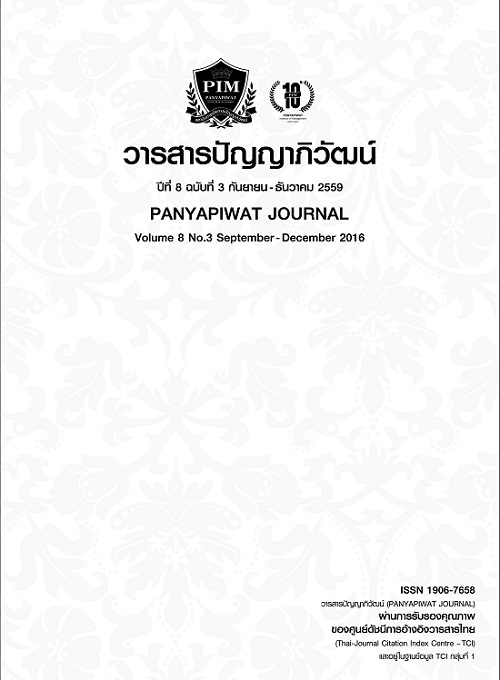แบบจำลองการวิเคราะห์อิทธิพลเชิงสาเหตุขององค์ประกอบด้านอุปสรรคและกฎเกณฑ์ในการส่งออกที่มีอิทธิพลต่อความสามารถในการส่งออก
Main Article Content
บทคัดย่อ
การวิจัยเรื่องนี้มีวัตถุประสงค์ คือ 1) เพื่อค้นคว้าองค์ประกอบที่เกี่ยวข้องกับอุปสรรคและกฎเกณฑ์ในการส่งออกของอุตสาหกรรมอาหาร และ 2) เพื่อพัฒนาแบบจำลองอิทธิพลเชิงสาเหตุของอุปสรรคและกฎเกณฑ์ในด้านการส่งออกของอุตสาหกรรมอาหาร ผู้วิจัยเก็บตัวอย่างแบบเจาะจงจากกลุ่มเป้าหมายจำนวน 145 ราย การวิเคราะห์ข้อมูลใช้สถิติพรรณนาในการวิเคราะห์ข้อมูล และวิเคราะห์อิทธิพลเชิงสาเหตุระหว่างตัวแปรตามกรอบแนวความคิดด้วยโปรแกรมลิสเรล ผลการวิจัยพบว่า อุปสรรคในการส่งออกไม่มีอิทธิพลต่อความสามารถในการส่งออก แต่กฎเกณฑ์ในการส่งออกมีอิทธิพลในทางบวกต่อความสามารถในการส่งออก ผลการประเมินความสอดคล้องกลมกลืนของกรอบแนวความคิด พบว่า กรอบแนวความคิดมีความสอดคล้องกลมกลืนดี โดยมีค่าไคสแควร์=31.85 ค่าองศาอิสระ=21 ค่าไคสแควร์สัมพัทธ์ (x2/df)=1.51 ค่าความน่าจะเป็น (P-value)=0.08 ค่าดัชนีวัดความกลมกลืน (GFI)=0.96 ค่าดัชนีวัดความกลมกลืนเปรียบเทียบ (CFI)=0.99 ค่าดัชนีความคลาดเคลื่อนในการประมาณค่าพารามิเตอร์ (RMSEA) เท่ากับ 0.55
The objectives of this research aim 1) to investigate factors which are related to the obstacles and regulations of food exporting industry and 2) to develop a model of causal influence of obstacles and regulations on food exporting industry. The researcher collected samples from a specific target group of 145 companies. Data were analyzed by using descriptive statistics. Moreover, the researcher also analyzed the causal influence factors between variables according to the conceptual framework by LISREL program. The results revealed that export obstacles had no influence on export capability. On the contrary, the analysis showed that export regulations had positive influence on the capability of exporting. Assessment on goodness of fit from the model found that export capability was consistent with the empirical data, the chi-square = 31.85, the degrees of freedom = 21, chi -square relative (x2/df) = 1.51, the probability (P-value) = 0.08, goodness of fit index (GFI) = 0.96, comparative fit index (CFI) = 0.99, Root mean square error of approximation (RMSEA) = 0.55.
Article Details
“ข้าพเจ้าและผู้เขียนร่วม (ถ้ามี) ขอรับรองว่า บทความที่เสนอมานี้ยังไม่เคยได้รับการตีพิมพ์และไม่ได้อยู่ระหว่างกระบวนการพิจารณาลงตีพิมพ์ในวารสารหรือแหล่งเผยแพร่อื่นใด ข้าพเจ้าและผู้เขียนร่วมยอมรับหลักเกณฑ์การพิจารณาต้นฉบับ ทั้งยินยอมให้กองบรรณาธิการมีสิทธิ์พิจารณาและตรวจแก้ต้นฉบับได้ตามที่เห็นสมควร พร้อมนี้ขอมอบลิขสิทธิ์บทความที่ได้รับการตีพิมพ์ให้แก่สถาบันการจัดการปัญญาภิวัฒน์หากมีการฟ้องร้องเรื่องการละเมิดลิขสิทธิ์เกี่ยวกับภาพ กราฟ ข้อความส่วนใดส่วนหนึ่งและ/หรือข้อคิดเห็นที่ปรากฏในบทความข้าพเจ้าและผู้เขียนร่วมยินยอมรับผิดชอบแต่เพียงฝ่ายเดียว”
เอกสารอ้างอิง
Arkolakis, C. & Muendler, M. A. (2010). The extensive margin of exporting product: A firm-level analysis. Retrieved August 10, 2011, from http://www.nber.org/papers/w16641.pdf?new_window=1
Barbosa, N., Guimarães, P. & Woodward, D. (2004). Foreign firms entry in an open economy: The case of Portugal. Applied Economics,36(5), 465-468.
Breinlich, H. & Cuñat, A. (2010). Trade liberalization and heterogeneous firm models: An evaluation using the Canada-US free trade agreement. Retrieved April 9, 2011, from http://eprints.lse.ac.uk/28725/1/dp0975.pdf
Breinlich, H. & Tucci, A. (2010). Foreign Market Conditions and Export Performance: Does ‘Crowdedness’Reduce Exports?. Working Paper. C.E.P.R. Discussion Papers, 7975.
Brouthers, L. E. & Nakos, G. (2005). The role of systematic international market selection on small firms’ export performance. Journal of Small Business Management, 43(4), 363-381.
Chetty, S. & Holm, D. (2000). Internationalisation of small to medium-sized manufacturing firms: A network approach. International Business Review, 9(1), 77-93.
Department of Trade Negotiations. (2001). Exports ratio and GDP. Retrieved July 15, 2012, fromhttp://www.dtn.go.th [in Thai]
Jayadevapa, R. & Chhatre, S. (2000). International trade and environmental Quality: A survey. Ecological Economics, 52, 175-194.
Kettunen, E. (2004). Regionalism and the geography of trade policies in eu-asean trade. Doctoral Dissertation, Helsinki School of Economics, Finland.
Knowledge of ASEAN Community. (2015). Food Industry Stepping into the AEC. Retrieved September 4, 2015, from http://www.thai-aec.com [in Thai]
Leonidou, L. (2004). An analysis of the barriers hidden small business export development. Journal of Small Business Management, 42(3), 279-302.
National Food Institute. (2015). Conclusion Thai Food Industry in 2014 and Outlook for 2015. Retrieved September 4, 2015, from www.nfi.or.th
Nguyen, H. T. (2000). The determinants and decision making process of export marketing activities in small and medium sized manufacturing firms in Germany. Dissertation, Nova Southern University.
Pak, J. M. (1991). The export behavior of firms: A study of determinants and decision making in small and medium sized manufacturing firm. Ph.D. Dissertation, University of Alabama.
Pasanen, M. (2003). In search of factors affecting SME performance: The case of eastern Finland. Doctoral Dissertation, University of Kuopio.
Pasit-Rattasin, S. (2001). Research Methodology in Social Science. Bangkok: FangFa Printer. [in Thai]
Porto, G. (2004). Informal export barriers and Poverty. Journal of International Economics, Corrected Proof, 1, 1-24.
Rae, A. & Josling, T. (2003). Processed food trade and developing countries: Protection and trade liberalization. Food Policy,28(2), 147-166.
Rasheed, H. S. (2005). Foreign entry mode and performance: The moderating effects of environment. Journal of Small Business Management,43(1), 41-54.
Shepherd, B. (2010). Geographical diversification of developing country exports. World Development, 38(9), 1217-1228.
Stoian, M., Rialp, A. & Rialp, J. (2010). Export performance under the microscope: A glance through Spanish lens. International Business Review,2(2), 117-135.
The Economist. (2012). GDP and trade growth. Retrieved July 15, 2012, from http://www.economist.com/node/18744587
The World Bank. (2015). Global economic perspectives. Retrieved November 1, 2015, from http://www.worldbank.org/en/publication/global-economic-prospects
Trendmizi. (2015). 2015 The year of AEC. Retrieved November 1, 2015, from http://www.trendmizi.com/2015the-year-of-aec/
Voerman, L. (2004). The export performance of European SMEs. Ph.D. Dissertation: University of Netherlands.
Wunder, S. (2008). Payments for environmental services and the poor: Concepts and preliminary evidence. Environment and Development Economics, 13, 279-297.
Wyman, O. (2015). Globalization in manufacturing industries. Retrieved November 2015, 1, from http://www.oliverwyman.com/content/dam/oliver-wyman/europe/germany/de/insights/publications/2015/jan/20141114_Globalization%20in%20Manufacturing%20Industries_Volume4_Global%20Organization_EN_screen.pdf
Zikmund, W. G. (2000). Business research methods. New York: Dryden.


